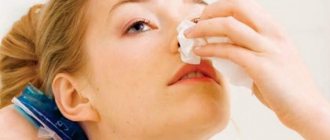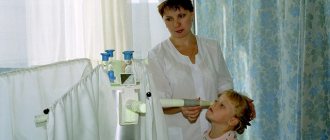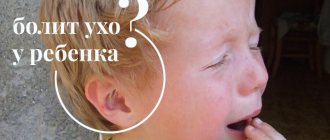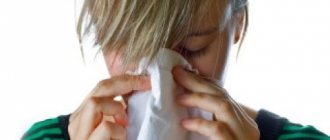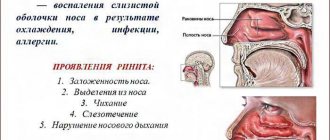Methods for removing foreign bodies from the nasal cavity in a medical facility
A foreign body in the nose sometimes comes off spontaneously (when you sneeze), but usually it is removed instrumentally.
In this case, it is necessary to prevent aspiration of a foreign body into the underlying parts of the respiratory tract. A small foreign body is removed with a blunt hook, which is inserted behind it. Extraction is carried out along the bottom of the nasal cavity in the direction from back to front. It is inappropriate (and in some cases dangerous) to remove a hard foreign body with tweezers. You should not try to remove a foreign body by blowing air (“Politzer douche”) or pouring water into the healthy part of the nose; this requires such high pressure that there is a danger of nasal discharge or douching fluid penetrating the auditory (Eustachian) tubes, as a result of which purulent inflammation of the middle ear will develop, and the foreign body will remain unremoved.
Thus, the requirements that are mandatory when removing a foreign body from the external auditory canal are erroneous in this case. You should not try to remove a round-shaped body with a forceps or tweezers (the attempt will be unsuccessful; moreover, when the branches of the instrument are closed, the round-shaped body moves deeper).
Attention! Do not attempt to remove a foreign body by blowing air or pouring water into a healthy nasal area. Only flat buttons and similar shaped objects are removed with forceps-like instruments (they can be installed in the nasal passage like wheels on a car and squeezed with forceps on both sides)
The same applies to soft objects - swollen peas, seeds, cotton balls, etc. To remove round objects, it is preferable to use a so-called ear spoon or a thick button-shaped probe, which can be easily bent into a curved shape.
Only flat buttons and similar shaped objects are removed with forceps-like instruments (they can be installed in the nasal passage like wheels on a car and squeezed with forceps on both sides). The same applies to soft objects - swollen peas, seeds, cotton balls, etc. To remove round objects, it is preferable to use a so-called ear spoon or a thick button-shaped probe, which can be easily bent into a curved shape.
With the help of such an instrument, one goes around over the object, directing the curvature or depression of the spoon behind the object and removes it, lifting up the end of the probe or instrument in the hand and pushing out the foreign body with a strong movement from back to front. In this case, it is necessary to hold the child tightly.
If the first attempt is unsuccessful or if the foreign body is large, located deep in the nasal cavity or at the top of the middle nasal passage, in a word, if it is difficult to see and reach, the child should not be tortured with extraction. It causes him pain, causes bleeding and makes it very difficult for another, experienced specialist, whose intervention in this situation is necessary, to remove it.
A foreign body in the nose has a number of dangers, so its removal should occur as quickly as possible so that an inflammatory reaction and swelling do not develop. Otherwise, the extraction process will be significantly more complicated. If a foreign body just gets into the nose, it can be removed by simply blowing it out.
If adults and small children were unable to remove the foreign body naturally, endoscopic removal is necessary. In young children, the procedure is performed under general anesthesia; for adults, local anesthesia is sufficient. A foreign body is removed surgically very rarely, only in cases where endoscopic removal was unsuccessful.
In addition to the above methods, rinsing the nasal cavity with antiseptic solutions, draining and rinsing the paranasal sinuses, and instilling vasoconstrictor drops into the nose are additionally used. If necessary, complications are treated.
What happens when you go to the doctor, complications
A child stuck a bead in his nose - what to do in such a situation. In a medical institution, a foreign body is removed in several ways:
- Blowing your nose. In this case, a vasoconstrictor is used, after which the child should blow his nose well and with maximum force. Objects that are round or small in shape, such as a bead, should come out on their own.
- Blunt hook and its use. In this case, you cannot do without local anesthesia. Next, the prepared hook is inserted, it catches the foreign body, which is carefully pulled out. If the case requires it, the procedure can be repeated several times.
- Surgical intervention is necessary when a foreign body has entered the nasal passage and cannot be removed due to penetration into the soft tissue. Operations are also carried out when there are objects with sharp edges in the nose that damage the mucous membranes.
If assistance is not provided in a timely manner, the following consequences may occur:
- Purulent, chronic rhinitis, rhinosinusitis.
- Swelling of the mucous membranes, causing difficulty breathing.
- Headache, manifested against the background of oxygen starvation.
- Development of rhinolitis (nasal stone) due to prolonged presence of a foreign object in the nasal sinus.
Rhinolitis, in turn, can lead to inflammation of the frontal and maxillary sinuses. Inflammation of the middle ear often manifests itself, nosebleeds make themselves felt, and perforation of the nasal septum occurs.
To avoid having to solve the problem described, it is better not to leave a curious baby exploring everything around unattended. If a foreign object is in the child’s nose, it must be removed by a qualified specialist. It is highly recommended not to do this.
Inept manipulations can only make it more difficult to remove the object from the nose and lead to complications.
Contents of the article:
classList.toggle()”>toggle
Children with beads and balls in their noses are quite common patients of otolaryngologists. This problem is not as simple as it seems. A foreign body in the nose can cause serious complications. Parents need to know what to do if a child puts a ball, bead or other small object up his nose, what measures to take, and when to see a doctor.
Complications of a foreign body in the nose
Foreign bodies in the nose lead to difficulty in nasal breathing and poor ventilation, which further provokes inflammatory changes in the paranasal sinuses. Prolonged stay of a foreign body in the nose can cause ulceration of the mucous membrane, necrosis of the nasal concha, the development of polypous growths, disorders of the lacrimal duct, and suppuration of the lacrimal sac.
In turn, the addition of a secondary infection provokes the development of purulent rhinosinusitis, and in some cases osteomyelitis of the bone structures of the nose. In addition, there are severe cases when a foreign body in the nose begins to perforate its wall. That is why, at the first symptoms of a foreign body in the nose, you should immediately consult a specialist.
You should understand what complications await a child and an adult if a foreign object is in the nose for a long time. If it is an insect, then even if it does not climb further along the passage, then sooner or later it will die and begin to decompose. Because of this, not only will an unpleasant odor be released, but an inflammatory process will also occur.
If fragile objects are in the nose, they can break down and move further along the respiratory tract. They will end up in the sinuses and throat.
Another serious complication of such an ailment as a foreign body in the nose (ICD code 10: T17) is sinusitis. It may be associated with meningitis, tonsillitis, osteomyelitis and some other serious diseases. That is why the sooner a foreign object is detected in a child or adult and appropriate measures are taken, the less likely it is that inflammation will begin. If the object could not be removed on your own, you should call an otolaryngologist at home.
Diagnostic methods
The easiest way to detect an object stuck in the nasal passage is to examine it from the inside using a rhinoscope. But this method only works with solid foreign bodies that have penetrated shallowly. But what if it is located somewhere above the upper sky? This is where hardware diagnostics are needed.
It usually starts with an x-ray. But not all objects can be seen on it. Metal and solid organic matter (seeds, pits, etc.) are clearly visible in the image. Rubber, plastic, and silicone are less visible. Small insects, grains of sand, grains, food particles are practically invisible on it. In this case, it is necessary to use computed tomography, which provides more detailed information.
In stationary conditions, the nasal passage is examined using an endoscope. It allows you to display an image from a miniature camera on a monitor, and at the end of the tube there is a special loop that you can immediately grab an object and remove it, if possible.
Consequences and possible complications
If first aid is not provided in a timely manner, the child may experience various complications.
Consequences of incorrect and untimely assistance:
- Development of chronic or purulent rhinosinusitis or rhinitis;
- Severe headaches (this is due to the fact that insufficient oxygen reaches the brain);
- Breathing problems;
- The development of such a dangerous disease as rhinolitis. It is characterized by the fact that phosphate salts of calcium and magnesium begin to settle on the surface of the object. These substances mix with the mucus of the nose and form capsules. They can be smooth or rough, soft or hard. Rhinoliths constantly irritate the mucous membrane and cause a runny nose.
How to tell if there is something in your nose
1. Bleeding from one nostril.
2. The appearance of mucus from one nostril, especially green in color with an unpleasant odor.
3
Increased attention of the child to one nostril, attempts to constantly pick at it
4. Inflammation of one of the axillary zones, often along with the other listed symptoms.
5. The occurrence of any problems with one nostril in the absence of other symptoms of acute respiratory infections.
What to do if a child has a foreign body in his nose
1. Determine which nasal passage is affected.
2. Place children's vasoconstrictor drops into the affected nostril to help relieve swelling. For example: Naphthyzin, Nazivin, Tizin, Otrivin, Nazol, etc.).
3. If the child is old enough to follow the adult’s commands, then you need to ask him to take a deep breath of air through his mouth and then try to exhale the foreign body, having previously blocked his mouth and the second (free) nasal passage.
4. If the child is not old enough to understand the dictated actions, then it is necessary to use the emergency aid technique for foreign bodies stuck in the nose - “Mom’s Kiss”. It consists in the fact that the mother takes a deep breath and blows it forcefully into the child’s mouth so that the foreign body flies out through the nasal passage. The reception should be repeated several times.
5. If none of the methods used helped achieve the result, you must seek medical help.
What actions should be avoided?
1. Do not try to remove a foreign body from the nose yourself using improvised tools - a cotton swab, tweezers, fingers or long nails. These actions can make the situation worse by pushing the object further into the nose or damaging the mucous membrane.
2. Do not rinse the child’s nasal passages yourself.
3. Do not press on the wing of the nostril in which a foreign object is stuck, to avoid further injury.
Medical assistance if a foreign body gets into the nose
An otolaryngologist is involved in removing foreign bodies from the nasal cavity.
.
Rhinoscopy of the nose is used as a diagnostic method in this matter.
, with the help of which, as a rule, it is possible to determine the size and location of a foreign body in the nasal passage.
Rhinoscopy
- This is an instrumental examination of the nasal cavity, in which a special instrument, a rhinoscope, is used.
In special cases, additional procedures may be prescribed such as:
- ultrasound diagnostics;
- tomography of the nasal sinuses;
- radiography;
- research using a probe.
In what cases should you seek medical help?
1. If the following foreign objects are found to be stuck in the nasal passage:
- a piece from a designer or another solid object of non-streamlined shape - such objects are difficult to remove;
- food or other body of organic origin - a washing procedure will be required to avoid the development of the rotting process;
- plasticine - when softened, it can be smeared throughout the entire nasal passage and requires particularly careful removal;
- coin - poses a risk of blocking breathing and causing asphyxia, requiring an urgent call for an ambulance.
3. If there is no positive result after performing the above steps to independently remove the foreign body from the nose.
4. After independently freeing the nasal passage from a foreign object, it would also be a good idea to contact a specialist to make sure that no undesirable consequences develop.
Live foreign bodies in the nose
Live foreign bodies in the nasal cavity may include worms (pinworms, roundworms, leeches), and insect larvae. Roundworms enter the upper respiratory tract from the digestive tract through vomiting or crawl there on their own. At the same time, children complain of headaches and discomfort in the nose. When moving and manipulating, roundworms can enter the sinuses, larynx, trachea and cause asphyxia, which can be fatal. Ascaris is removed from the nasal cavity using tweezers.
Pinworms that have entered the nasal cavity from the stomach are destroyed by lubricating the nasal mucosa with menthol oil, and then removed with tweezers.
When drinking water from stagnant bodies of water, leeches can enter the nasopharynx and crawl from it into the nasal cavity, which is accompanied by bleeding, difficulty in nasal breathing, and itching. The leech is removed by grasping it with tweezers.
In addition, fly larvae can enter the nasal cavity, which, using a suction apparatus, attach to the mucous membrane and cause its destruction (as well as the periosteum and underlying bone); When manipulating, special care is required due to the possibility of penetration into the orbit and brain.
Metal foreign bodies and so-called lost teeth are diagnosed by radiography of the nose and skull bones in lateral and frontal projection.
Children complain of headaches in the frontal and parietal areas. Some people experience dizziness, which sometimes leads to diagnostic errors. Excessive mucus with ichor and an unpleasant odor appears from the nose (a tumor must be excluded). When the larvae move, irritation of the nasal mucosa occurs, so children often sneeze, and this can lead to diagnostic errors.
The diagnosis is made using anterior rhinoscopy, in which white moving larvae are identified on the mucous membrane. To clarify the diagnosis, the use of optics is necessary. Then the nasal mucosa is anemized and the larvae are removed with nasal tweezers.
What to do if a child puts a bead in his nose
If there is a suspicion that the child has a foreign object in the nose, you need to carefully examine the nasal passages in good lighting. If it is clearly visible, you can try to remove it by following these steps:
- Tilt the child's head
forward, close the free nostril with your finger and ask the child to blow his nose forcefully; - To provoke sneezing,
for this, in a position with a bowed head, you can let the baby smell ground pepper, or tickle the nasal passage with a feather or a thin cotton wool. When sneezing, close the free nostril with your finger; - If the child is small
and cannot understand what is required of him, you can sit him in your arms, pinch the free nasal passage with your finger and sharply exhale some air into his mouth, as is done with artificial respiration.
If a bead, ball or other small object falls out, you need to examine the nose to see if there is any bloody discharge, and drip children's vasoconstrictor drops (sanorin, nazol, rhinonorm). Nasal breathing is quickly restored. But even with successful removal, you need to consult with an ENT doctor the next day.
If a bead, ball or other small object cannot be removed, you must ask the child to breathe only through the mouth, or pinch both nostrils with your fingers and cover them with a plaster.
This is very important so that when inhaling through the nose, an object does not enter the nasopharynx or trachea and cause suffocation. Next, you need to urgently take your baby to the doctor.
At night, you can go to an urgent children's hospital, where there is an ENT doctor on duty.
In order not to harm the baby when providing first aid, you should absolutely not perform the following actions:
- When laying the child down, he should be in a sitting position. A horizontal position may help propel a small object into the trachea;
- Rinse your nose with water and other solutions for the same reasons;
- Trying to remove a bead, ball or other small object using your finger, tweezers, sticks, hooks and other objects can push it deep and damage the nasal mucosa;
- Press firmly on the nostril in which the object is located;
- Place oil in your nose to make it easier for the object to come out. When inhaling through the nose, on the contrary, it can shift towards the respiratory tract.
It should also be remembered that it is better for young children (under 5 years old) not to try to remove a foreign body at home.
They may not be able to accurately follow instructions to blow their nose or sneeze, so it is best to take your child to the hospital right away.
Causes
The reasons for foreign objects entering the nasal cavity are:
- Targeted introduction;
- Accidental inhalation;
- Objects left behind after medical procedures (including the patient’s own tissue);
- while eating (when a person chokes);
- Entry through vomit.
There are many reasons for this development of events. Only children, as well as people with mental disabilities, do this purposefully. But foreign objects do not appear randomly so often. It is not uncommon that with the help of protective reactions of a mechanism such as sneezing, it is possible to get rid of IT in the nose.
"Mom's Kiss"
The essence of this method is that you actually have to blow through the child's nose. Here's how it's done.
The last step is best done in two stages
First, gently blow into your baby's mouth until you feel some air resistance. It means that the baby instinctively closed his larynx to prevent air from entering the lungs
Then exhale sharply and forcefully into the child’s mouth. The air you exhale will push the stuck object out of your open nostril.
If it doesn't work the first time, try again. According to statistics, this method works in 60% of cases. Efficacy and safety of the “mother's kiss” technique: a systematic review of case reports and case series. .
Even if you fail to get rid of the foreign object this way, you will likely push it closer to the edge of the nostril, making it easier for the doctor to remove it.
A little person is constantly learning about the world around him, and often such research leads to problems. If you leave your baby unattended for a long time, a foreign body may get into his nose. The situation is especially dangerous if a child puts a bead or other round object up his nose. Signs of this problem immediately make themselves felt with the following symptoms: nasal congestion; labored breathing; secretion of copious mucus; paroxysmal sneezing; bleeding. Parents should know what to do in this situation, since the likelihood of complications depends on the speed of their actions: Tilt the child’s head forward and ask him to take a sharp breath through his mouth, and then exhale through his nose, or simply blow his nose. Provoke sneezing by tickling the nasal passages with a feather or letting a little ground pepper smell. In this case, the head should be lowered, and the healthy nostril should be covered with a finger
This should be done very carefully, if the stuck object is large or has sharp edges, it can damage the mucous membrane. For the same reason, you should not try to rinse your nose with water or use tweezers. If the baby is at an age when he does not yet understand what adults want from him, it is better to sit him on your lap, pinch the free nasal passage and sharply inhale air through his mouth. If all measures do not bring results and the small object cannot be removed, you should call a doctor, having first explained the situation
If you ignore the primary symptoms, there may be consequences in the form of infection: nasal discharge will turn yellow or green; a characteristic unpleasant odor appears; inflammation will occur and the temperature will rise. To prevent such a situation, you should remove all small objects from the baby’s field of vision. And games must take place in the presence of adults.
Foreign objects in children's noses can be of organic or inorganic origin.
In the first case, these are most often seeds, nuts, berries, candies, vitamins, as well as solid pieces of food - vegetables, fruits, crusts of bread, cookies. In addition, this includes various insects that can fly into the nose when a child is walking outside.
Items of inorganic origin are everything that a child may encounter at home or in kindergarten:
- beads, buttons, wheels from cars, small construction parts, cotton wool, pieces of paper, plasticine, small coins, buttons, paper clips, nails;
- fragments of nasal bones, glass, stones that ended up in the nasal cavity as a result of trauma to the nose and its sinuses.
As you understand from the composition of the material, the texture of its surface and the variety of shapes, foreign bodies are quite diverse.
According to the time of presence in the nasal cavity, foreign bodies are divided into:
- spicy. These are those that were recently (minutes, hours) introduced into the nasal cavity;
- chronic. These are those that are present in the nasal cavity for quite a long time (several days and months);
- rhinolitis. They are also called nose stones. They are formed due to the long-term presence of a foreign body in the nose. As a result, it becomes overgrown with connective tissue, which is formed due to damage to the mucous membrane by a foreign object and the development of inflammation.
Diagnosis of a foreign body in the nose
If a foreign body has recently entered the nose, the easiest way is to blow your nose intensively. If there is no effect, a solution of adrenaline or drops with a vasoconstrictor effect is sprayed into the nasal cavity and blown out again.
Removing a foreign body using tools.
Before removing it, children are anesthetized using a 10% lidocaine solution. Preschoolers may need anesthesia.
The instrument is selected depending on the characteristics of the foreign body. To remove a foreign body from a soft (cotton wool, paper, grass) or hard elongated (match) material, use tweezers. A round-shaped solid foreign body with a smooth surface is removed using a nose hook.
Surgery is required to remove rhinoliths, or in case of serious injury to the nose.
In case of unilateral nasal congestion, purulent or sanguineous-purulent discharge from it with an unpleasant odor, anamnesis is ascertained, rhinoscopy is performed, palpation with a probe, etc. To reduce swelling, a 0.1% solution of adrenaline is used. A small foreign body with swelling and bleeding of the mucous membrane, when it is surrounded by lush granulations or is located in the posterior parts of the nasal cavity, is easier to find using optics. Metallic foreign bodies and so-called stray teeth are diagnosed using radiography and computed tomography of the nose (CT).
Computed tomography of the nasal cavity (CT) to determine the depth of penetration of foreign bodies into the nasal cavity.
Most often, if parents do not go to the doctor immediately, but after some time, diagnosis becomes very difficult. This is due to the fact that the object is securely fixed in the nose and a period of remission begins. In order to detect it, you need to perform a special procedure called rhinoscopy.
It is most difficult to diagnose this problem in those children who cannot or are afraid to talk about what they feel, or if they simply do not feel the presence of a foreign body in the nose. In such cases, an x-ray is prescribed in 3 projections.
If the object is poorly visible, then contrast agents are used together with computed tomography. Thanks to this method, you can identify any object, as well as understand and distinguish it from sinusitis or diphtheria.
In order to protect children, it is necessary to constantly monitor their activities. However, there are cases when it is impossible to provide round-the-clock supervision, especially if the child is not the only one. Therefore, there are preventive measures that will help reduce the likelihood of such a problem occurring.
Children should not be left unattended when they are in a room with small objects. You also need to remember that toys such as construction sets are for children over 3 years old. That is why younger children should not buy them. The same applies to collapsible dolls and cars.
Also, before giving fruit to your child, you need to remove the seeds from them. It is necessary to remove all small items from shelves and surfaces where children can reach them. Unless, of course, you want your child to stuff a bead or paperclip up his nose.
If we are talking about children of preschool and primary school age, then it is necessary to conduct conversations that will keep them safe on the street and at home, and it is necessary to explain what the consequences may be if they do not listen.
In adults, preventive measures come down to constantly taking care of your teeth and avoiding facial injuries.
An otolaryngologist is responsible for diagnosing a foreign body in the pharynx based on medical history, results of rhinoscopy and examination of the nasal cavity. Much more problems arise with diagnosing foreign bodies of the nose in young children. Very often, their medical history contains no indication of a foreign object entering the nose.
It is also difficult to diagnose a foreign body that has been in the nasal cavity for a long time. The fact is that due to severe edema, formed granulations or inflammatory changes in the mucosa, it may not be visualized during rhinoscopy. To detect a foreign body in the nose in such situations, palpation with a metal probe is used. True, this method can only detect dense foreign bodies.
In case of a foreign body in the nose, an ultrasound, culture of nasal discharge, CT or radiography of the paranasal sinuses, pharyngoscopy, CT or radiography of the skull are additionally performed.
How to determine if there is a foreign body in the nose
Even if you constantly monitor your child, a foreign object may end up in his nose. It takes literally a couple of seconds to stick or accidentally inhale a small object or piece of food into your nose. Even if a child speaks well, he still does not understand his feelings well and may not notice that there is something in his nose, so parents have to guess for themselves about the trouble that has happened based on the following signs:
- the child’s nose is stuffy, but only on one side;
- the skin around the nostril, in which something got into, turns red;
- discharge appears from the nose despite the absence of a cold;
- The child suddenly begins to sneeze and his eyes water.
Sometimes the entry of a foreign body is complicated by certain circumstances. For example, if the “object” that gets in is a piece of food and it begins to rot and decompose, or if the parents failed to realize in time that something got into the nose, and the inflammatory process has already begun. In this case, more “severe” symptoms appear:
- purulent discharge (sometimes with blood) and a putrid odor appear from the nose;
- a purulent runny nose occurs, but only on one side;
- the mucous membrane in the nasal cavity becomes inflamed (rhinosinusitis);
- There may be a headache on the side of the nostril in which the foreign object is located.
What to do if a foreign body gets into your nose
First, you need to examine the child and assess the situation: can you handle it yourself or do you need the help of a doctor. If the object is not stuck deeply and is clearly visible, you can act independently:
- we give the baby drops to relieve swelling of the mucous membrane caused by a foreign object getting into the nose;
- We ask the child to blow his nose only through one nostril - the one in which the foreign object is located (the second must be pinched).
If you didn’t get away with “a little blood”, it’s better not to engage in amateur activities and go to the hospital. It is especially dangerous to try to get an object that is stuck deep yourself. In this case, parents begin to try to get it out with a cotton swab or tweezers, but in the end they only push the object even deeper.
If a child’s nose bleeds when a foreign object hits them, they should contact a doctor immediately, without even trying to solve the problem themselves.
Symptoms of a foreign body in the nose of a child or adult - how to recognize it in young children?
Summarizing the above once again, let us note the features of foreign bodies in the nose.
Objects with sharp edges usually cause nasal pain and bleeding, foreign bodies that swell, make breathing difficult and lead to inflammation with purulent discharge. Small foreign bodies with a smooth surface can remain in the nose for a long time asymptomatically, sometimes they enter the nasopharynx, larynx, trachea and bronchi. To date, the etiology of rhinoliths remains unclear. Apparently, the cause of their formation is not always a foreign body.
The severity of the manifestation depends on the size of the foreign body in the nose, its location and the age of the patient. The most common symptoms are: child restlessness, breathing problems, excessive mucus, nose picking, trouble sleeping, nasal nasal sound. Your baby may experience headaches, dizziness, and problems with appetite.
If a foreign body is in the nose for too long, then over time there will be skin irritation, inflammation and swelling, bad breath and nose, fatigue, tearfulness, and constant pain in the head. Most of the symptoms are localized in one of the nostrils, but if the foreign object is in both parts of the nose at once, then the congestion and secretion of copious mucus will become bilateral.
As a rule, foreign bodies are localized in the common nasal passage.
However, there are situations when they end up in the lower or middle nasal passage, in the vestibule of the nose - or deep in the posterior sections of the nasal cavity, in the area of the choanae.
Let's look at the basic symptoms.
The clinical picture of a foreign body in the nose, which got there naturally (i.e. through the nasal passages), is often obvious. And sometimes the only sign of a foreign body entering the nasal cavity is nasal congestion on one side.
- The person immediately begins to experience discomfort in the form of tickling, a feeling of something foreign.
- He also sneezes.
- He has lacrimation and watery-mucous discharge from the nose.
But these symptoms, as practice shows, can be short-lived - and even disappear without making themselves felt for a long time. And in general, discomfort is not always considered the main symptom.
Pain. It develops in the nasal cavity itself, where, for example, a sharp piece of metal gets in - it injures the internal tissues of the organ and provokes hemorrhage, or another object. Your head, cheek, etc. may hurt.
Signs of the presence of acute foreign bodies in the nose are similar to the picture of acute rhinitis (runny nose).
Children complain about:
- itching in the nasal cavity (itching in the nose);
- difficulty breathing through the nose;
- frequent paroxysmal sneezing;
- copious watery discharge from the nose;
- bleeding, since if the nasal mucosa is damaged, there may be blood-streaked discharge or nosebleeds;
- pain in the nose when the mucous membrane is injured by a foreign object.
Adult patients almost always talk about when and what they put into their nose. Children are an exception. They are often afraid that they will be punished by their parents for their mischief, and keep silent about what happened. Therefore, it is important for parents to detect and remove a foreign body as soon as possible in order to avoid the development of complications.
The entry of a foreign object into the nasal cavity may be accompanied by reflex sneezing, lacrimation and watery discharge from one half of the nose. True, such symptoms pass very quickly, after which the patient will not feel anything. For example, small foreign bodies in the nose, which have a smooth surface, can occur for a long time without clinical manifestations. There are cases when even objects with sharp corners and rough foreign bodies in the nose did not cause complaints in the patient, and for quite a long time.
Under the influence of a foreign object, the nasal mucosa is injured, which provokes a strong inflammatory process, which is accompanied by clinical symptoms such as pain in the nose and mucous or mucopurulent discharge from one half of the nose. As a result of inflammation, swelling of the nasal mucosa occurs, which makes nasal breathing difficult.
In other cases, a foreign body in the nasal sinuses immediately after entering the nose causes various kinds of discomfort:
- feeling of a foreign object;
- irritation;
- tickling;
- pain in the affected side of the nose.
Pain associated with a foreign body may radiate to the forehead, pharynx, or cheek. The most pronounced pain syndrome is with foreign bodies with sharp corners; this can be any metal object. Such objects greatly damage the internal tissues of the nose and often provoke nosebleeds.
For a foreign body in the nose, the classic triad of symptoms is pain, discharge and nasal congestion. These symptoms are bilateral in nature, which distinguishes them from the manifestations of allergic rhinitis, rhinitis and sinusitis. A foreign body in the nose in children is most often accompanied only by a runny nose with discharge that comes from one half of the nose.
Certain foreign bodies in the nose that remain in it for a long time undergo some changes. For example, beans and peas from the humid environment of the nose significantly increase in size, which leads to blocking of nasal breathing, but only that part of the nose in which they are localized. Some foreign bodies can break down into pieces over time and even disintegrate completely.
In the case when the foreign body of the nose does not resolve and leaves its original appearance, in the future it can become the core of a nasal stone. It is worth noting that it is formed by deposits of salts, which are contained in the secretion of the nasal mucosa. If a foreign body remains in the nasal cavity for a long time, this will increase the risk of developing granulation tissue; its growth provokes constant injury to the mucous membrane. Granulation tissue will hide the nasal foreign body, making it difficult to visualize during diagnosis.
